If you’ve spent any time in a roadracing paddock you’ve seen some wacky motorcycles. From highly modified basement-built frankenbikes to metal-flake supersport machines, people’s idea of what a racebike should look like varies a lot. And it’s for exactly that reason that I was skeptical of this Krämer HKR-EVO2. What the hell is a Kramer? Where did it come from? Am I really going to sling myself around a racetrack on a bike I’ve never even seen?
To answer those questions in reverse order: yes, Germany, and it's not so much "what" as "who." Markus Kramer, together with two colleagues, created the HKR in 2009 based on their own desire to race and a shared belief that a unique, capable racebike was within their grasp. The target was European "supermono" competition, a series designed for single-cylinder bikes, many of which are custom. They started with a KTM 690 Duke powerplant mated to a custom frame. The bike they created was dubbed the EVO1, and after four years of development was superseded by the EVO2, essentially the bike I tested.
The 2016 version that I raced uses the updated, 105mm-bore KTM 690 engine which has a little more potential than the mill used in older 690 models. A raft of KTM parts are used to fill in many of the gaps—a combination of RC8 fork and triple clamp holds a Super Duke front wheel and off-the-shelf KTM front-brake calipers. The shock is from an RC8 as well, though the spring-rate is different and the valving has been tweaked to suit the needs of the Kramer. A rear wheel and axle from a 690 Duke completes the basic rolling chassis.
A few familiar outside brands are used for the details. A Coso gauge, for example, shows RPM, speed, and (for some reason) the date. There’s a Translogic quickshifter to pop up through the 6-speed gearbox and an Akrapovic muffler keeps 690cc power pulses below ear-splitting levels. I know what you’re thinking and yes, there are a ton of custom parts, too. Rearsets, frame, subframe, bodywork, windshield, and swingarm are all among the parts made just for this bike.
Easily the slickest made-for-Kramer part is the fuel tank, which doubles as the rear subframe and the seat. It's rotomolded plastic spun to hold 3.2 gallons of high-test fuel, and bolts to the rear of the steel-tube main frame with four basic mounts. That leaves room for an airbox where the fuel tank would normally be, which feeds a 690 Duke engine that is surprisingly unmodified aside from the intake and ignition timing that's aggressive enough that the HKR requires high-octane race gas to avoid detonation. The swingarm is another Kramer part, and is mated to the shock in a way that offers two ride height settings and two linkage ratios—either a straight-rate travel of 100mm or a progressive-rate 120mm of travel.
The only other nuance to the Kramer is that there are two stages of HKR-EVO2: an S model and the up-spec R. The S uses a single 320mm front-brake rotor, cast wheels, and a simpler intake and engine tune that yields a claimed 75 horsepower. The R model comes equipped with dual 290mm rotors up front, forged wheels, and a more aggressive tune that squeezes 81 hp from the mill. You can also get custom-painted bodywork and frame with the R spec, instead of the standard white-gelcoat finish and green frame on the S.
I processed all of this info via a phone call to Kramer’s US headquarters in West Fargo, North Dakota while my good buddy Ari held the wheel of the van and drove us through the most barren section of Interstate 5, three racebikes (including the HKR) strapped in the back. It made me feel better about the bike, basically an unknown quantity other than being clearly radical, and about flying around Sonoma Raceway the next day. Turns out the bike Kramer USA had loaned us was somewhere between S and R, with the R-spec engine tune and dual front rotors but the S’s cast wheels and basic paint.
The first thing I noticed about the HKR was how comfortable it is—at 6-foot-2 sometimes racebikes don’t fit—despite being very compact and weighing in just under 280 pounds. There’s plenty of legroom, and even though it’s narrow the clip-ons are set fairly wide, which put me in a perfectly commanding riding position. The next thing was much more obvious: torque. KTM’s 690cc single pumps out plenty of low-end grunt, and reacquainting myself with Sonoma’s rolling, wine-country curves was made easier with truly linear power on tap.
Over the next two days of racing I discovered a few more tidbits. One, the brakes are vicious. So incredibly strong and with absolutely the best feel I’ve ever experienced. I think it’s due in part to the HKR’s sub-300-pound weight, but it reminded me that overkill brakes are exactly what I want. Deceleration is made easier and a little more exciting by the slipper clutch, which works impeccably. This bike was tuned to have pretty high drag, which meant I had to get used to the back end sliding around as I entered corners hard on the brakes. Fortunately, I felt like I had ultimate control and I literally burst out laughing in my helmet on more than one occasion.
Once I calibrated to the power, quickshifter, and brakes, it was time to find out whether or not the HKR really worked the way it should. Luckily I shod the bike with ultra-sticky Bridgestone Battlax V02 slicks, so I knew it would stick. And the more I pushed the Kramer the more impressed I was at how beautifully it handled. The term, “apex-seeking missile” has been used again and again in articles like this over the years, but it’s absolutely the term that kept coming to mind. There was almost no mistake I could make that would destabilize the HKR. It changed direction as fast as I dared, and always felt terrific mid-corner. The only niggle I had with the Kramer’s handling was high-speed direction changes (Sonoma’s fast, downhill esses in this case), where I would get a bit of head-shake in the front end—until it was on the side of the tire, that is, when stability would return.
The Kramer proved to be a potent track weapon, able to keep up with (and beat) Yamaha FZ-07Rs and Suzuki SV650s. Indeed, I went even faster on the HKR-EVO2 than I did when I raced a fully-prepped FZ-07R previously. To be fair, the HKR family comes at a similar price. While the Kramer posed in the paddock all weekend, I had people approach and guess the price half a dozen times—speculations ranged from $10,000 to $30,000. The HKR is in the middle, with the S model’s 2018 pricing set at $15,990 and the R will be $20,990. That’s a bump from the ‘16/’17 pricing and borderline exotic, especially for a custom that uses the beating heart of a sub-$10,000 bike. That said, the 2018 bikes will be upgraded as well—a new swingarm for both, plus the R gets an option for carbon-fiber wheels, and a few other updates.
As any racer will tell you, going to the track is not a cheap proposition. Reasonably priced racebikes can be had, but to fully prepare a 600 supersport or even an SV650 for high-level competition can easily cost between $10,000 and $20,000. It should also be noted that the Kramer offers similar benefits to middleweight twins in that it won’t burn up tires like a 600 or 1000 supersport bike (I used one set of slicks all weekend). There’s also the stock KTM 690 powerplant, for which it’s easy enough to source clutch plates, pistons, or any other internal engine part. Where the HKR doesn’t help the wallet is in finding parts—being rare and sexy will come at a price if you break a rearset or need to replace parts that are custom.
If it’s not one thing it’s another. The fact remains that three Germans built a motorcycle based on a dream for a spicy supermono and hit the nail right on the head. The Kramer HKR-EVO2 is a stellar machine, worthy of praise and worth your best effort on a racetrack.










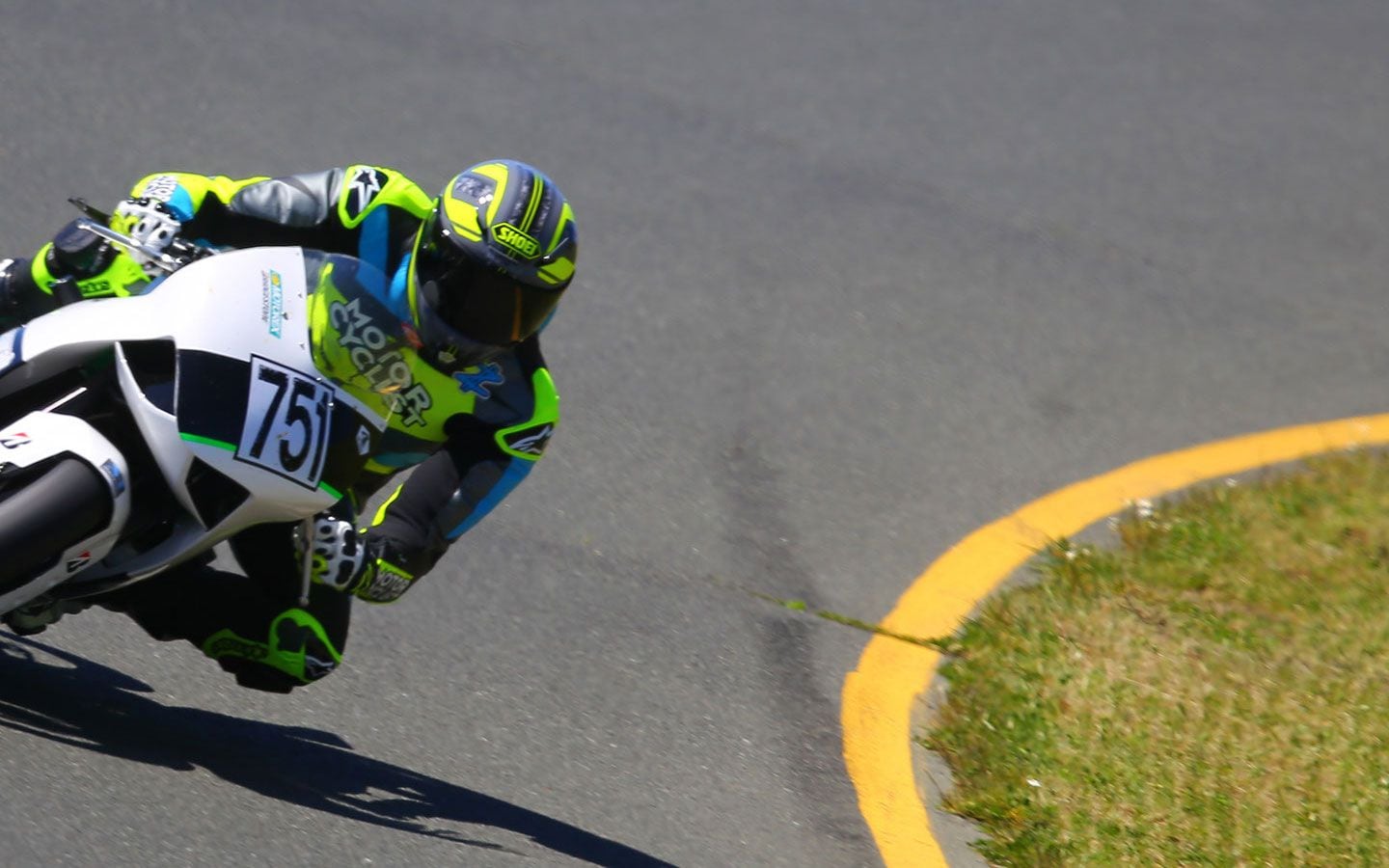

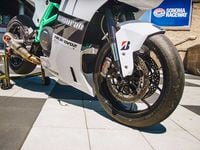

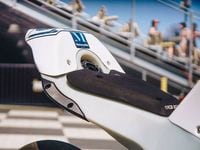

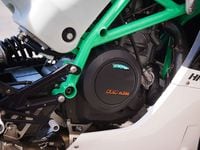
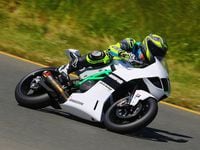

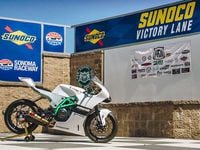
/cloudfront-us-east-1.images.arcpublishing.com/octane/S35YGSEMEZB4BLTDJTSZPF4GLA.jpg)
/cloudfront-us-east-1.images.arcpublishing.com/octane/5UOT6HPX2JFMRJAX6EH45AR4MQ.jpg)
/cloudfront-us-east-1.images.arcpublishing.com/octane/OKWOJWAKP5EP3OACCRRWPCIX2Q.jpg)
/cloudfront-us-east-1.images.arcpublishing.com/octane/2WF3SCE3NFBQXLDNJM7KMXA45E.jpg)
/cloudfront-us-east-1.images.arcpublishing.com/octane/G4MG6OUCJNBSHIS2MVVOTPX65E.jpg)
/cloudfront-us-east-1.images.arcpublishing.com/octane/IIGGWFOTOJGB7DB6DGBXCCMTDY.jpg)
/cloudfront-us-east-1.images.arcpublishing.com/octane/QSTCM6AVEZA5JJBUXNIQ3DSOF4.jpg)
/cloudfront-us-east-1.images.arcpublishing.com/octane/U4I7G625B5DMLF2DVIJDFZVV6M.jpg)
/cloudfront-us-east-1.images.arcpublishing.com/octane/B6XD6LS6IVCQPIU6HXDJSM3FHY.jpg)
/cloudfront-us-east-1.images.arcpublishing.com/octane/ICL63FEDDRDTTMINYICCEYGMDA.jpg)
/cloudfront-us-east-1.images.arcpublishing.com/octane/FCGZHQXRBZFLBAPC5SDIQLVF4I.jpg)
/cloudfront-us-east-1.images.arcpublishing.com/octane/WNOB6LDOIFFHJKPSVIWDYUGOPM.jpg)

/cloudfront-us-east-1.images.arcpublishing.com/octane/X33NU3E525ECRHXLNUJN2FTRKI.jpg)
/cloudfront-us-east-1.images.arcpublishing.com/octane/6KKT5NNL2JAVBOXMZYS5ZO76YA.jpg)
/cloudfront-us-east-1.images.arcpublishing.com/octane/J5RKG5O455GMPGQRF2OG6LRT7A.jpg)
/cloudfront-us-east-1.images.arcpublishing.com/octane/GX2CIZKQVRH2TATDM26KFG2DAE.jpg)
/cloudfront-us-east-1.images.arcpublishing.com/octane/ZWIDYSAKQZHD5BHREMQILXJCGM.jpg)
/cloudfront-us-east-1.images.arcpublishing.com/octane/CYUHJZCTSJCH3MRAQEIKXK7SCQ.jpg)
/cloudfront-us-east-1.images.arcpublishing.com/octane/LKOFINY56FCXJCANJ5M7ZDQUBY.jpg)
/cloudfront-us-east-1.images.arcpublishing.com/octane/4NBPDACMWJH63JQYJVK3QRBDZI.jpg)
/cloudfront-us-east-1.images.arcpublishing.com/octane/KKHQHRR3FJGX7H2IPU6RALMWG4.jpg)

/cloudfront-us-east-1.images.arcpublishing.com/octane/5IOFS5JAE5FOXMNA23ZRAVVYUU.jpg)